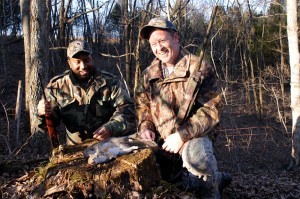Change hunting strategies for late season squirrels
Author Art Lander Jr.
Feb. 10, 2011 Contact: Art Lander, Jr.
FOR IMMEDIATE RELEASE 1-800-858-1549, ext. 4414
FRANKFORT, Ky. – Squirrel hunting during the last month of Kentucky’s 106-day fall season is a much different experience than early fall.
In winter, the food that squirrels are looking for is mostly on the ground.

“They create a cache of nuts and seeds,” said Ben Robinson, small game biologist for the Kentucky Department of Fish and Wildlife Resources. “They go back to the nuts they have buried or stashed in tree cavities.”
In August and September, the leaves are still on the trees. Hickory nuts, acorns, beechnuts and walnuts are just starting to ripen. Squirrels abound in the leafy treetops; the spot and stalk method is the best hunting strategy. Shotguns are ideal for the early season because squirrels are in thick foliage and partially hidden most of the time.
In winter, food is in much shorter supply, so hunters may have to look for remaining food sources to find squirrels.
“By Kentucky standards this has been a cold winter, and snow on the ground makes finding food more difficult for squirrels. There’s also a lot of competition for acorns from deer, wild turkey and bear,” said Robinson.
With the leaves down, the forest floor is often dry and crunchy. It’s not as easy to walk quietly. Squirrels are on the ground more and are quick to pick up movement. A successful late season hunting strategy is to sit tight and wait for squirrels to appear.
Shots tend to be longer, so .22 rifles and small-caliber muzzleloaders are ideal for bagging squirrels in late season.
Hunter harvest of squirrels drops off in the late season in part because there are fewer hunters. The 2009-10 Squirrels Hunter Cooperator Survey indicated hunter effort is greatest toward the beginning of the fall season and declines as the season progresses.
According to the survey, about 4 percent of squirrel hunts were held in January and around 2 percent in February. About half as many squirrels were observed then compared to August and September.
Squirrel season continues through Feb. 28, 2011, with a daily bag limit of six squirrels.
Author Art Lander Jr. has been writing about the outdoors since the 1970s. He is a staff writer for Kentucky Afield Magazine.
-30-
The Kentucky Department of Fish and Wildlife Resources manages, regulates, enforces and promotes responsible use of all fish and wildlife species, their habitats, public wildlife areas and waterways for the benefit of those resources and for public enjoyment. Kentucky Fish and Wildlife is an agency of the Tourism, Arts and Heritage Cabinet. For more information on the department, visit our website at fw.ky.gov.


Be the first to comment